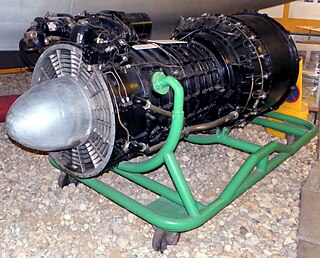
The Junkers Jumo 004 was the world's first production turbojet engine in operational use, and the first successful axial compressor turbojet engine. Some 8,000 units were manufactured by Junkers in Germany late in World War II, powering the Messerschmitt Me 262 fighter and the Arado Ar 234 reconnaissance/bomber, along with prototypes, including the Horten Ho 229. Variants and copies of the engine were produced in Eastern Europe and the USSR for several years following the end of WWII.

The Lyulka AL-21 is an axial flow turbojet engine created by the Soviet Design Bureau named for its chief designer Arkhip Lyulka.

The Soloviev D-30 is a Soviet two-shaft low-bypass turbofan engine, officially referred to as a "bypass turbojet". It is probably the single most important turbofan engine developed in Soviet Union to date. Development of the turbofan spurred numerous growth versions with increased fan diameter and modified component arrangements. Developed within an amazingly short period of time, the engine turned out to be one of the most reliable engines in the history of Soviet engine development. The D-30 development was recognized with the USSR State Prize.

The Metropolitan-Vickers F.2 is an early turbojet engine and the first British design to be based on an axial-flow compressor. It was an extremely advanced design for the era, using a nine-stage axial compressor, annular combustor, and a two-stage turbine.

The Ilyushin Il-30 was a Soviet turbojet-powered tactical bomber designed as a higher-performance, swept wing version of the Ilyushin Il-28, in the late 1940s. Its thin wing and engine nacelles necessitated the use of tandem landing gear, the first Soviet aircraft to do so. It was apparently canceled before the prototype made its first flight, although sources disagree with this.
The Tumansky R-13 is a Soviet turbojet engine designed by Sergei Alekseevich Gavrilov.

The Lyulka AL-7 was a turbojet designed by Arkhip Mikhailovich Lyulka and produced by his Lyulka design bureau. The engine was produced between 1954 and 1970.

The Klimov RD-500 was an unlicensed Soviet copy of the Rolls-Royce Derwent V turbojet that was sold to the Soviet Union in 1947. The Klimov OKB adapted it for Soviet production methods and materials.
The Tumansky R-15 is an axial flow, single shaft turbojet with an afterburner. Its best known use is on the Mikoyan-Gurevich MiG-25.

The General Electric YJ93 turbojet engine was designed as the powerplant for both the North American XB-70 Valkyrie bomber and the North American XF-108 Rapier interceptor. The YJ93 was a single-shaft axial-flow turbojet with a variable-stator compressor and a fully variable convergent/divergent exhaust nozzle. The maximum sea-level thrust was 28,800 lbf (128 kN).

The Fairchild J44 was a small turbojet developed in the 1940s by the Fairchild Engine Division.

The General Electric J73 turbojet was developed by General Electric from the earlier J47 engine. Its original USAF designation was J47-21, but with innovative features including variable inlet guide vanes, double-shell combustor case, and 50% greater airflow was redesignated J73. Its only operational use was in the North American F-86H.
The Lyulka TR-1 was a turbojet designed by Arkhip Lyulka and produced by his Lyulka design bureau. It was the first indigenous Soviet jet engine.
The Lyulka TR-3 was a Soviet axial turbojet designed after World War II by Arkhip Mikhailovich Lyulka.

The SNECMA ATAR 101 is a French axial-flow turbojet engine built by SNECMA. It was derived from engines and design work carried out at BMW in Germany during World War II, and extensively developed though a progression of more powerful models. The name is derived from its original design group, Atelier Technique Aéronautique de Rickenbach employing Hermann Östrich and many of the wartime BMW gas turbine design group as well as other German engine design teams. The ATAR 101 powered many of the French post-war jet aircraft, including the Vautour II, Étendard IV, Super Mystère B2, and the Mirage III-001, prototype of the Mirage III series.

The Yakovlev Yak-1000 was a Soviet supersonic technology demonstrator intended to evaluate the aerodynamic layout and field performance of the cropped delta wing discussed in captured German documents in combination with the new Lyulka AL-5 turbojet. The tandem undercarriage proved to be unsatisfactory and there were serious flight stability problems related to the delta wing, enough so that it never flew after an accident during taxiing tests.

The Tumansky R-29 is a Soviet turbojet aircraft engine that was developed in the early 1970s. It is generally described as being in the "third generation" of Soviet gas turbine engines which are characterized by high thrust-to-weight ratios and the use of turbine air cooling.
The Tumansky R-21 was a Russian turbojet engine of the 1960s. Used for development only, the project was canceled.
The Mikoyan-Gurevich I-350, was a Soviet Cold War-era experimental fighter aircraft. It was the first Soviet aircraft able to maintain supersonic speed.
The Klimov VK-3 was the first Soviet afterburning bypass turbojet engine. Designed by S V Lyunevich at Klimov, at OKB-117 in 1949, this engine first ran in 1952, and was qualified at 5,730 kg (12,632 lb) thrust (dry) and 8,440 kg (18,607 lb) thrust in 1954. The VK-3 was developed for the Mikoyan-Gurevich I-3 (I-380) and I-3U/I-5 (I-410) fighters. First flown in the I-3U in July 1956, the engine's performances was good but its reliability was poor. Even after modifications in December 1956 when newly designed compressor blades were installed, developmental problems continued, the program was ultimately canceled in January 1958. The engine was superseded by the Lyulka AL-7F, a less modern but more efficient engine.